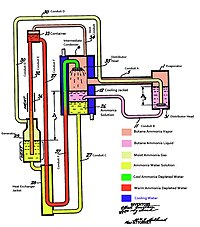Einstein refrigerator


The Einstein–Szilard or Einstein refrigerator is an absorption refrigerator which has no moving parts, operates at constant pressure, and requires only a heat source to operate. It was jointly invented in 1926 by Albert Einstein and his former student Leó Szilárd patented it in the US on November 11, 1930 (U.S. patent 1,781,541). This is an alternative design from the original invention of 1922 by the Swedish inventors Baltzar von Platen and Carl Munters.
History
From 1926 until 1933 Einstein and Szilárd collaborated on ways to improve home refrigeration technology. The two were motivated by contemporary newspaper reports of a Berlin family who had been killed when a seal in their refrigerator failed and leaked toxic fumes into their home. Einstein and Szilárd proposed that a device without moving parts would eliminate the potential for seal failure, and explored practical applications for different refrigeration cycles. Einstein used the experience he had gained during his years at the Swiss Patent Office to apply for valid patents for their inventions in several countries, the two eventually being granted 45 patents in their names for three different models.
It has been suggested that most of the actual inventing was performed by Szilárd, with Einstein merely acting as a consultant and helping with the patent-related paperwork.[1]
The refrigerator was not immediately put into commercial production, the most promising of their patents being quickly bought up by the Swedish company Electrolux. A few demonstration units were constructed from other patents.
Present day
In September 2008 it was reported that Malcolm McCulloch of Oxford University was heading a three-year project to develop more robust appliances that could be used in locales lacking electricity, and that his team had completed a prototype. He was quoted as saying that improving the design and changing the types of gases used might allow the design's efficiency to be quadrupled.[2]
A similar refrigeration device has been proposed by Adam Grosser at a TED Talk in 2008,[3] but has not made it into production as of 2015.
See also
- Refrigeration
- Refrigeration cycle
- Absorption refrigerator
- Rudolf Goldschmidt (for the Einstein–Goldschmidt hearing aid)
- Icy Ball
- Timeline of low-temperature technology
Notes
- ^ Dannen, Geene (1997), "The Einstein–Szilard Refrigerators", Scientific American, 276 (1): 90–95, doi:10.1038/scientificamerican0197-90
- ^ Alok, Jha (21 September 2008). "Einstein fridge design can help global cooling". The Guardian.
{{cite news}}: Cite has empty unknown parameter:|coauthors=(help) - ^ http://www.ted.com/talks/adam_grosser_and_his_sustainable_fridge
References
- Einstein, A., L. Szilárd, "Refrigeration" (Appl: 16 December 1927; Priority: Germany, 16 December 1926) U.S. patent 1,781,541, 11 November 1930.
- Einstein, A., L. Szilárd, "Accompanying notes and remarks for Pat. No. 1,781,541". Mandeville Special Collections Library USC. Box 35, Folder 3, 1927; 52 pages.
- Einstein, A., L. Szilárd, "Improvements Relating to Refrigerating Apparatus." (Appl: 16 December. 1927; Priority: Germany, 16 December 1926). Patent Number 282,428 (United Kingdom). Complete accept.: 5 November 1928.
External links
- Einstein’s Refrigerator Using No Electricity/No Freon Revived at Oxford
- Flanigan, Allen, "[1] (German site) Wolfgang Engels from the University Oldenburg rebuilt the original concept— the housing is manufactured out of concrete, i.e. the total mass of the completed apparatus is around 400 kg with 20 kg of alcohol in the refrigeration cycle. The project was completed in 2005.
- Patent document US1781541 (European Patent Office)
- Patent document GB282428 (European Patent Office)
- How kerosene refrigerators work. Archived version of page.
